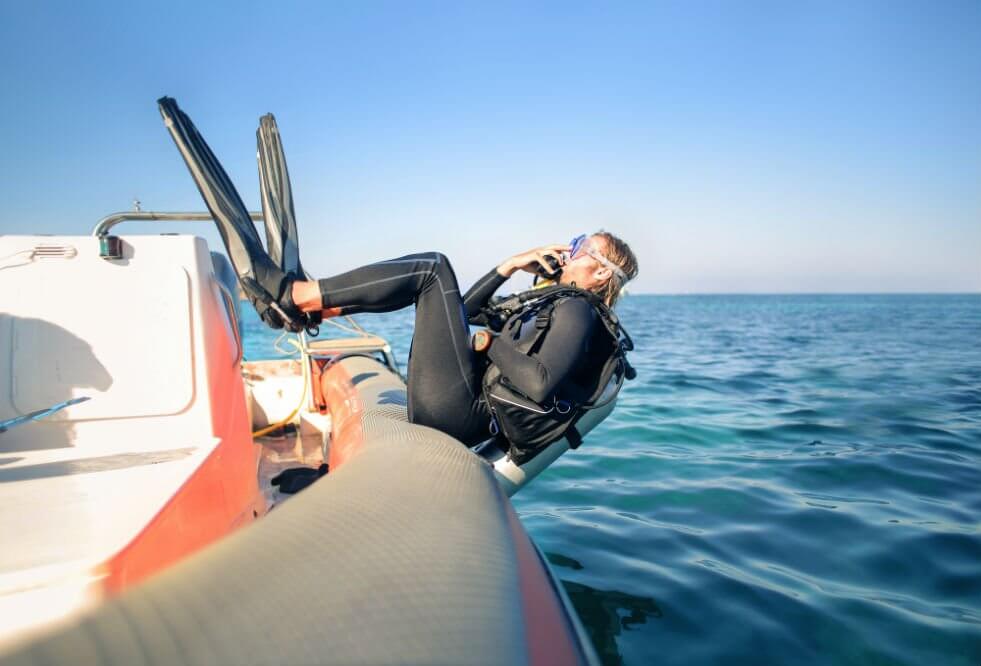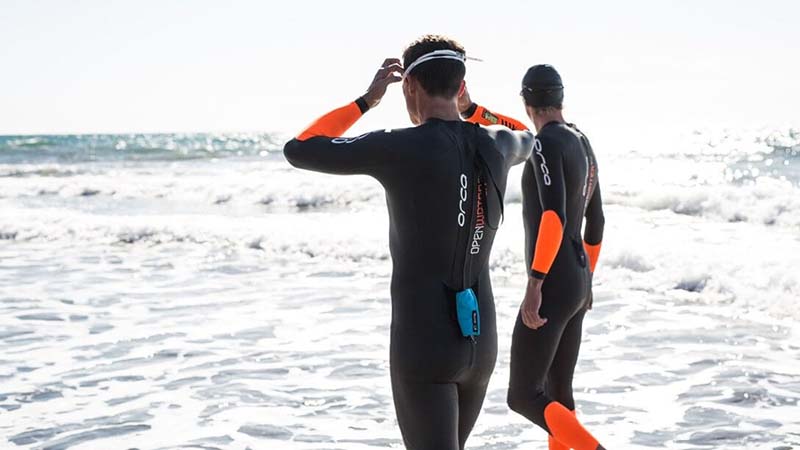How does a wetsuit work? This is one of the frequently asked questions that both beginners as well as advanced divers ask.
After you complete your diving certification course, which could be PADI, NAUI or even SSI training, you will be yearning to go and dive. However, you will find that you still do not know a lot about many diving related things.
What is a wetsuit?
If this is the first time that you are reading any of my articles, or perhaps you are a beginner diving or snorkeling enthusiast, you may not know what a wetsuit is.
If you would like to see wetsuits in their full glory, you may buy yours from Amazon.com. You will be amazed at the array that is available there. If you are a diving family, you will be happy to know that you can even buy diving wetsuits for children.
This is a special suit made with rubber (neoprene) for people that love spending a lot of time in water. Swimmers, divers, surfers, stand up paddle boarders kayakers, and people who revel in other types of water adventures mostly wear wetsuits.
Of course, the name wetsuit, or wetsuit for diving is intriguing on its own. The reasoning is that if it is a wetsuit, how then does it keep you warm in water? Another thing that many people ponder about is whether it keeps you dry.
To stay dry when diving, you would need to use a drysuit. A wet suit is going to make you wet. However, even as it makes you wet, it is still going to keep your warm. In fact, even when diving in moderately cold water, a wetsuit for diving can still keep you warm.
How does a wetsuit work – It traps body warmth

How does a wetsuit keep you warm? Actually, it is very simple. Physics shows that heat flows from warmer places to colder places. In this case, the warmer place is your body and the cold place is the water surrounding you. Therefore, all that a scuba diving wetsuit does is prevent the heat from escaping from your body to the cold surroundings.
The wetsuit traps a thin layer of water between the body and the wetsuit itself. This layer of water acts as the buffer zone between the warmth of your body (you are a warm-blooded mammal, remember?) and the cold wetsuit plus the cold ocean outside. Thus, the cold of the ocean cannot get to you and at the same time, your body warmth cannot escape through the buffer zone.
Let’s assume for a moment that your body temperature is 95° F when you are in the wetsuit, before stepping into the water. Let us also assume that the temperature of the water that you are going to dive in, snorkel in or surf in is 40°F.
This is quite a difference between your body temperature and that of the water. Thus, when you step into the water, your body could rapidly lose heat to the water and eventually, the body temperature will come down close to that of the water.
And that is damn cold! Very cold. How long would you survive in that water? Not a long time, before your body uses the fat reserves for heat generation and later, you could die of hypothermia.
With a wetsuit though, you will only lose a little body heat, before your temperature stabilizes. This happens as soon as the buffer zone of thin layer of water between your body and the wetsuit is trapped.
In cold water, you are apt to lose your body warmth faster than you would lose it in cold air. The reason for this is that cold water is thicker, with more molecules surrounding you. Air is thinner and as a result, you do not lose body heat as fast as in water. A wetsuit keeps you safe in the water.
How does a wetsuit work – made with neoprene
There is no doubt that neoprene scuba diving suits are the best. There are good reasons for this. The first one is that neoprene is a special material that contains thousands of minute air bubbles that enable it to float.
This tiny air bubbles also help to trap the warm air against your body, thus protecting you from the cold water.
Neoprene can also stretch very well without losing shape. However, this does not mean that you should force your bulk into a wetsuit that is made for a size far smaller than yours. It is paramount that you get a wet suit for your size. When you buy one from amazon.com, you will find that they come true to size. Thus, you can always order on with confidence that it is going to fit you perfectly.
How a wetsuit works – It protects you

Not all underwater dangers require you to carry a scuba diving knife. Some of them are subtle in nature, yet at the same time, very harmful.
A wetsuit for deep water diving therefore not only protects you from the cold, but it also protects you from dangers like jelly fish stings when snorkeling.
Since you will need to take your scuba weights for diving, your scuba tank and your scuba BCD for diving, well, you can be sure that you do not want them to get into direct contact with your skin. That is the reason why you need a wetsuit.
A wetsuit also protects you from the protruding edges of rocky reefs. Many people have hurt themselves in the reefs. If you start bleeding in the water, you could attract different marine animals, even sharks.
The best type of wetsuit to insulate your body
In simple terms:
- Thick wetsuit is best for cold water diving – 5 to 7mm wetsuits made of neoprene
- Thin wetsuit is best for warm water diving – 2 to 4mm wetsuits made of neoprene
Not every wetsuit will work for you when diving in cold water. This is the reason why you should wear a diving suit that fits your snugly!
If it is even a fraction of an inch larger, well, it will not effectively create an air lock zone. That is why you see that many divers wear wetsuits that look like a second skin on them, so snug and fitting.
A badly fitting wetsuit for snorkeling is also not a good idea because it hinders your movement in the water. Now, if you have to use more energy to move when diving, it means that you will spend the air in your scuba diving tank faster. You know you will only stay underwater for as long as your air lasts. Remember, you will also be carrying other diving gear, which means you need to preserve your energy.
The kind of wetsuit that you need to keep you warm depends on many things. However, the biggest factor among them all is that for cold water diving, you will need a thicker wetsuit.
Now, when you are going walking in cold weather, you wear many thin layers instead of just one heavy coat. The reason for wearing layers is because they help in trapping heat.
It is the same with a wetsuit. Some are made of layers of neoprene. Some are just one heavy neoprene material.
What is most important to know is that the thicker the neoprene suit like this one that you can buy one from Amazon.com, the better it is for diving in cold water.
The best wetsuit design
So far, I believe you now have an idea of how a wetsuit works to keep you warm and protect you from obvious and not so obvious dangers.
Thinner wetsuits are only good for diving in warm water. If you dive for long in cold water with a thin wetsuit, you will be setting yourself up for hypothermia and you can be sure it is not pleasant.
Now, you ought to know something else. One of them is that wetsuits come in different designs, each with its own distinct advantages.

Another thing that we may mention about wetsuit design is that the torso and the front can be made of thick neoprene. However, the crotch and the armpits are made of thinner neoprene to allow flexibility for movement.
The zippers, which can be at the front or the back are sealed for more protection. Wrist and ankle cuffs complete the picture for you.
Here are the most common types of wetsuits:
Shorty wetsuits
These are called shorty because it has short sleeves and short leggings. It is not a full wetsuit. Because it does not cover as much as a wetsuit, this type of suit is best used for warm water diving.
This is the kind of wet suit that you want to wear when diving or snorkeling in Clearwater. The shorty wetsuit is also a favorite for surfers. Do not be surprised to see many shorty suits on the white sand beaches of California.
Full length wetsuits
These are full length, just as their name suggests. They cover the torso and the legs all the way to the ankle and foot joint. They will also cover the full arm length to the wrists. To complete the full length suit look, you may also wear a pair of the best diving gloves, a wetsuit hood and scuba booties. Such a look is good for diving in low water temperatures.
Vests and trunks
When you diving in the warm waters of the Arabian Sea in Dubai, you may not need to wear a full length wetsuit. You may choose to wear a pair shorty trunks only. This can be complemented with a vest if the need should arise.
All of these – shorties, full length, vest and trunks are made of neoprene. Thus, they all work in the same way.
So how does a wetsuit work?
As we have said here, a wetsuit traps a thin layer of water, which in return creates a lock so that your body heat does not escape to the surrounding environment. But that alone does not explain how a wetsuit really works.
Wetsuits work by getting wet and letting a layer of water stay next to your body. This means that there is no water getting in or out as that would mean your body having to work overtime to warm all the cold water coming in.
Conclusion
Hopefully, you now know the answer to the question of how does a wetsuit work. As you have seen here, it is pretty ingenious that a wetsuit keeps you warm by holding water in, rather than letting water in and out of the suit. Remember, even when you are swimming or scuba diving in hot weather, a wetsuit will protect your from jellyfish stings and other dangers of snorkeling. Besides, you have to agree that you look dashing hot in your scuba diving photos, wearing a wetsuit.






